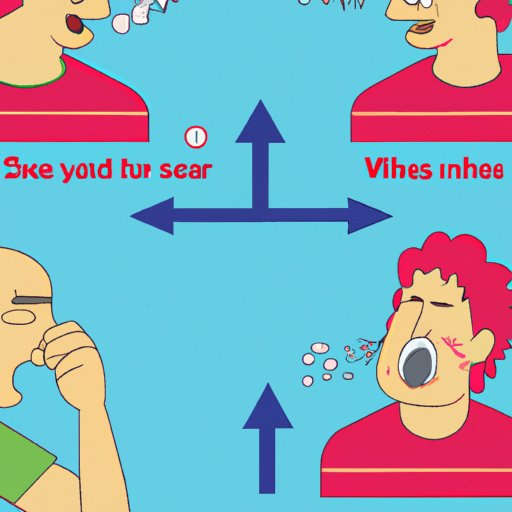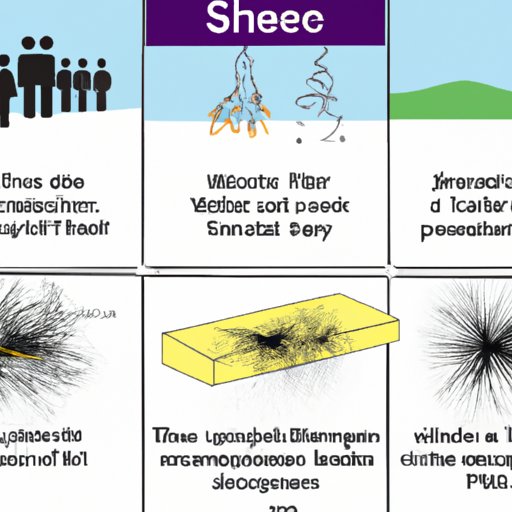Introduction
A sneeze is a reflex action that occurs when your body is trying to expel irritants from your nose. It involves a sudden, forceful expulsion of air through your mouth and nose. While it may seem like a small thing, a sneeze can have a big impact. This is especially true in light of the current pandemic, where understanding the distance of a sneeze is more important than ever.

A Scientific Look at How Far a Sneeze Travels
In order to understand how far a sneeze can travel, there are several factors that need to be taken into account. These include the size of the droplets emitted, the force with which they are expelled, air pressure, wind direction, and the environment in which the sneeze takes place. By looking at these factors, we can get a better idea of the range of a sneeze.
Factors Affecting the Distance of a Sneeze
The size of the droplets emitted during a sneeze plays a large role in determining how far it can travel. Smaller droplets evaporate more quickly, limiting their range. Larger droplets, however, can remain airborne for longer periods of time, increasing the potential distance of a sneeze.
The force with which a person sneezes also affects the distance of a sneeze. A powerful sneeze will create larger droplets that can travel farther. The environment in which the sneeze takes place is also important. In enclosed spaces, such as a classroom or office, the droplets are less likely to dissipate quickly, allowing them to spread farther.
Calculating the Reach of a Sneeze
To calculate the approximate reach of a sneeze, researchers have used a combination of mathematical models and experiments. One study found that a typical sneeze can travel up to 8 meters (26 feet). This figure is based on an average-sized droplet traveling at an average velocity of 100 mph.
Another experiment found that, depending on the environment and the force of the sneeze, it can travel up to 10 meters (33 feet). This suggests that, under certain conditions, a sneeze can travel farther than previously thought.

How to Keep Yourself and Others Safe by Knowing the Distance of a Sneeze
Knowing the approximate distance of a sneeze can help you protect yourself and others from infection. By maintaining a safe distance from anyone who is sneezing, you can limit your exposure to any airborne droplets.
Maintaining Social Distancing
Social distancing is one of the most effective ways to prevent the spread of disease. The World Health Organization recommends keeping a minimum distance of 1 meter (3 feet) between yourself and anyone who is sneezing. This will help to reduce the risk of inhaling any droplets that may have been expelled.
Wearing Protective Gear
In addition to social distancing, it is also important to wear protective gear when around someone who is sneezing. Wearing a face mask or covering your nose and mouth with a tissue can help to reduce the risk of infection.

Exploring the Physics Behind How Far a Sneeze Can Go
In order to understand the reach of a sneeze, it is important to look at the physics behind it. By looking at the speed of a sneeze, air pressure, and wind direction, we can get a better idea of its range.
The Speed of a Sneeze
The speed of a sneeze is determined by the amount of pressure behind it. According to one study, the average sneeze travels at a speed of 100 mph. This means that a sneeze can travel up to 8 meters (26 feet) in just a few seconds.
Impact of Air Pressure and Wind Direction
Air pressure and wind direction can also affect the distance of a sneeze. Strong winds can disperse the droplets further, while low air pressure can keep them close to the ground. Wind direction is also important, as it can push the droplets in different directions.
What You Need to Know About the Range of a Sneeze
In order to stay safe and protect others, it is important to understand the distance of a sneeze. Knowing the approximate reach of a sneeze can help you take steps to limit your exposure to any airborne particles.
Distance of a Sneeze
The distance of a sneeze can vary depending on the size of the droplets, the force with which they are expelled, air pressure, and wind direction. On average, a sneeze can travel up to 8 meters (26 feet). However, under certain conditions, this distance can increase to 10 meters (33 feet).
Understanding the Spread of Germs
The spread of germs is a major concern during the current pandemic. It is important to understand how far a sneeze can travel in order to limit your exposure to any airborne particles. By maintaining a safe distance from anyone who is sneezing and wearing protective gear, you can reduce the risk of infection.
The Danger Zone: Examining the Reach of a Sneeze
The danger zone for a sneeze is the area within the reach of the droplets. This area can be affected by several factors, including the size of the droplets, the force with which they are expelled, air pressure, and wind direction. To stay safe, it is important to know the approximate distance of a sneeze and take steps to limit your exposure.
Measuring the Contagiousness of a Sneeze
The contagiousness of a sneeze is determined by the number of droplets that are expelled. Studies have shown that a single sneeze can contain up to 40,000 droplets, increasing the risk of infection for anyone within the danger zone.
Identifying High Risk Areas
High risk areas for a sneeze include enclosed spaces, such as classrooms and offices. In these environments, the droplets are less likely to dissipate quickly, increasing the potential reach of a sneeze.
Comparing the Distance of a Sneeze to Other Common Illnesses
It is important to understand the reach of a sneeze in comparison to other common illnesses. This can help to identify high risk areas and determine the best way to protect yourself and others.
Influenza
The reach of influenza is similar to that of a sneeze. Studies have shown that a single sneeze can travel up to 10 meters (33 feet), while the flu virus can remain infectious up to 6 meters (20 feet). This makes it important to maintain a safe distance from anyone who is sneezing or exhibiting signs of the flu.
Cold
The reach of a cold is slightly shorter than that of a sneeze. Studies have found that the cold virus can remain infectious up to 4 meters (13 feet). This means that it is important to stay at least 4 meters away from anyone who is suffering from a cold.

An Overview of the Science Behind the Spread of a Sneeze
In order to understand how far a sneeze can travel, it is important to look at the science behind it. By looking at the size of the droplets, the force with which they are expelled, air pressure, and wind direction, we can get a better idea of the reach of a sneeze.
The Role of Microscopic Particles
The droplets emitted during a sneeze are made up of microscopic particles. These particles can remain suspended in the air for long periods of time, increasing the potential reach of a sneeze. The smaller the droplets, the longer they can remain airborne.
Prevention and Treatment
In order to reduce the risk of infection, it is important to take steps to limit your exposure to any airborne particles. This includes maintaining a safe distance from anyone who is sneezing, wearing protective gear, and washing your hands frequently. If you do become infected, it is important to seek medical attention as soon as possible.
Conclusion
Sneezing is a reflex action that can have a big impact on our health. By understanding the distance of a sneeze, we can take steps to protect ourselves and others from infection. By maintaining a safe distance from anyone who is sneezing, wearing protective gear, and washing your hands regularly, we can reduce the risk of infection and help to keep our communities safe.
(Note: Is this article not meeting your expectations? Do you have knowledge or insights to share? Unlock new opportunities and expand your reach by joining our authors team. Click Registration to join us and share your expertise with our readers.)
